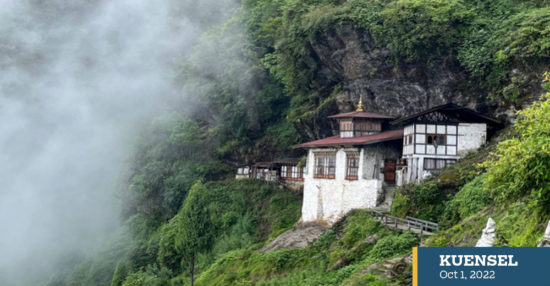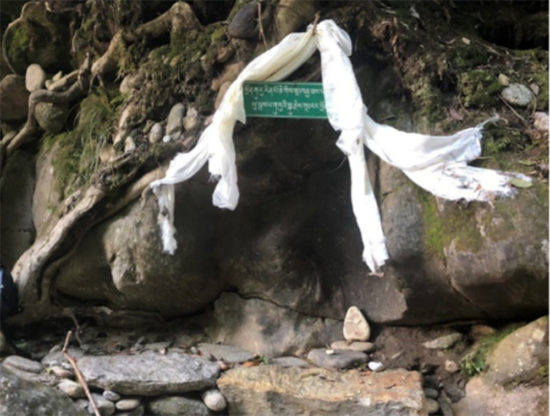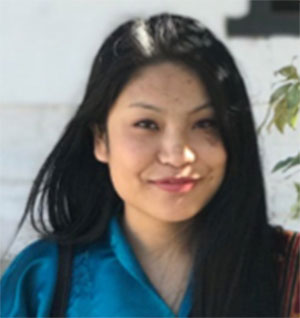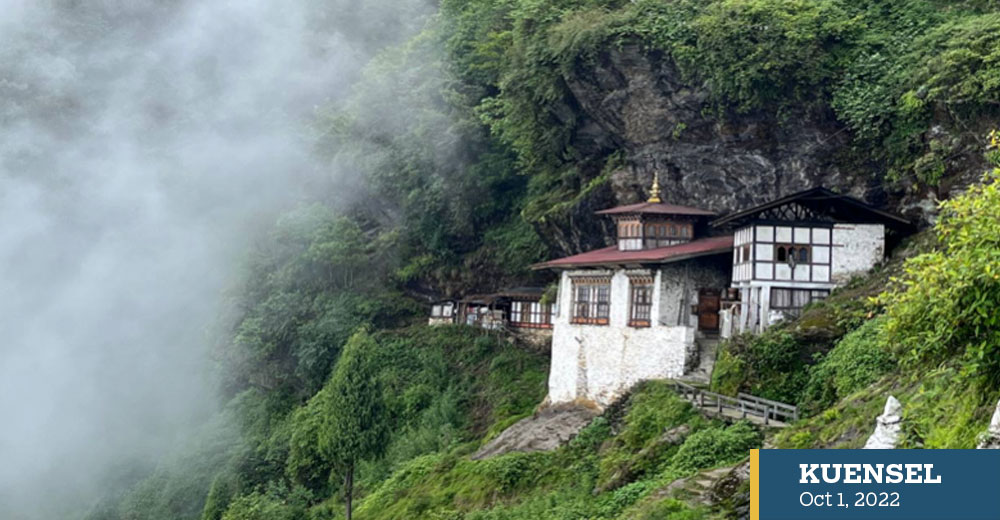Entering Mongar district is a door to a multi-dimensional destination brimming with historical landmarks, cultural pursuits, natural wonders, and societal intricacies, offering an incredible and fascinating window into a diverse way of life and beliefs in the Zhonggar Tshodhuen (Seven Valleys).
The dzongkhag covers an area of 1,954 sq. km with elevations ranging from 400m to 4000m asl. Historically, Mongar was known as the “bastion of the Zhongarps” as some of the finest administrators in the country were born here. The district is strategically located and is often considered as the capital of eastern Bhutan. The region is one of the largest dzongkhags and is enclaved by Trashigang, Lhuentse, Pemagatshel, Samdrup Jongkhar and Zhemgang districts. This has led to the proliferation of a unique multi-dimensional cultural identity of the dzongkhag.

Aja Ney

Hike to the mystical Larjab Drakar Choeling
Surrounded by alpine forests and mountains, Larjab Drakar Choeling Lhakhang in Yakpogang, Mongar gewog, was built sometime between 1701 and 1707 by Drupthob Kuenzang Chophel, a disciple of the 9th abbot of Bhutan, Je Khenpo Shakya Rinchen. Larjab literally means “behind the mountain”. It is said that at the spot where the temple was built, Drupthob Kuenzang Chophel subdued an evil spirit which had assumed a human form. It is said the temple was miraculously built by sky dancers (dakini), empowered by Drupthob’s wisdom. Resembling a Rhino’s Horn, the temple is said to have been built with small pebbles at the bottom (foundation), with bigger boulders used as the construction grew in height. Over the years, given its sanctity, the temple attained a special status as the “Taktshang of the east”. Today, the monastery has a Drubdey (a retreat for meditation) for lay monks established by Gyeltshen Truelku. The Larjab Drakar Choeling is reachable by a day-long hike.
Sacred Aja Ney and Aja-Ugyen Draphu-Sheridzong Trail
The renowned Aja Ney is located at an altitude of more than 3,500 meters under Sherimuhung Gewog. The most sacred are the 100 imprints of the sacred syllable “Aa” on the rock-cave left by Guru Rinpoche besides numerous other sacred sites. The Nye also has a medicinal spring which the locals believe can cure 18 diseases besides a nearby pool called Awa Chhu (now known as Uma Chuu). It is said to remove defilements in a person. It takes a minimum of three days to complete a pilgrimage to all the sacred sites.
There is a belief that Omba Ney of Trashi Yangtse, Aja Ney of Mongar and Hungrel Dzong of Paro are three equally important religious sites in Bhutan because their names start with the letters Om, Ah and Hung to complete the Buddhist Mantra of Om Ah Hung. The trail connecting Aja Ney and Ugyen Draphu in Mongar, and Sheri Dzong in Mongar-Trashi Yangtse border has made pilgrimage more convenient. The pilgrims can further trek to either Trashi Yangtse or Phuningla in Lhuentse via a trail connecting three districts.
Drametse Thekchog Namdrol Ugyen Choeling Monastery
Drametse Lhakhang was built in 1511 by Ani Choeten Zangmo, a descendant of Terton Pema Lingpa (1450-1521). The blessings of Zhabdrung Ngawang Namgyal were multiplied by three succeeding incarnations, Zhabdrung Jigme Drakpa (1791-1830), Zhabdrung Jigme Norbu (1831-1861), and Zhabdrung Jigme Chogyal (1862-1904). Both the Kudung (the bodily remains of Ani Choeten Zangmo) and the Kapala of Dakini, which bears the self-arisen words OM AH HUNG, are kept at the monastery. The Kapala was once again found by Terton Pema Lingpa and preserved in Tamzhing Lhuendrup Choeling’s Taen Gam (treasure box) until Ani Choeten Zangmo was given it as a part of inheritance.
After finishing the construction of Samye Monastery in 769 AD, Guru Rinpoche and Khandro Yeshi Tshogyal are believed to have hidden it. The monastery not only has unique collection of significant manuscripts, murals, and religious sculptures, but it is also the home of the Dance of the Drums of Drametse.
Drametse Nga-chham
The Mask Dance of the Drums of Drametse was choreographed there in the 16th century after the monastery’s founder, Kunga Gyeltshen, the great grandson of Terton Pema Lingpa, had a vision of Guru Rinpoche’s Zangtopelri (Copper-Colored Mountain Paradise). A total of 16 male dancers wearing masks and 10 musicians perform the dance. They first perform a prayer dance in the main shrine, and then, one by one, they enter the monastery’s courtyard. The dance is divided into two sections: a quiet, meditative portion that symbolizes the tranquil deities, and a swift, athletic portion that symbolizes the wrathful ones. The quintessence of Bhutanese identity, this dance has been performed for nearly five centuries all over the country. Now, it has become a crucial component of Tshechu in Bhutan. Dramétsé Nga-chham was designated as a “Masterpiece of the Intangible Heritage” at the Third Proclamation of Masterpieces of the Oral and Intangible Heritage of Humanity by UNESCO in Paris in November 2005 because of its worldly, spiritual, and artistic values.
Wengkhar Nagtshang
Wengkhar Nagtshang is renowned and venerated for being the birthplace of Zhabdrung Jigme Drakpa (1725–1761), the third reincarnation of Zhabdrung Ngawang Namgyel. Its artifacts include gold-written religious texts, sculptures, and holy items belonging to Zhabdrung as well as his personal rosary, headpiece, and monk’s garb and the carpet on which he worshiped. The numerous relics are displayed to the public during a religious ritual that takes place on the tenth day of the third month of the Bhutanese calendar.
Yakgang Sang-ngag Choeling Lhakhang
The Yakganag Lhakhang was built by Sangdag, the youngest son of Terton Pema Lingpa sometime in the 16th century. The temple is renowned for its special and unique treasures, including a statue of the Buddha that Terton Pema Lingpa found in Mebartsho, a three-sided Phurpa (sacred dagger) that Pema Lingpa found in Ugordra in Tibet, a dakini’s skull from Samye Chimphu Nadrak, and a Naga king’s skull. The temple also exhibits xylograph blocks, musical instruments, weaponry, and armor and masks from ancient times. The Buddhas (past, present, and future) as well as statues of Guru Rinpoche, Chenrizig, Terton Pema Lingpa, and Gyapo Lhashang can be found on the ground floor. When Choekhor Deb, a local king, attempted to open the treasure chest disclosed by Pema Lingpa, three statues were said to have escaped flying to Jakar Dzong, the Dongkala monastery, and to Yakgang Lhakhang.
Mongar is one of the fastest developing districts in the East. It is a home of diversity that offers a variety of exciting experiences, many of which will be covered in the coming weeks.

Article contributed by Karma Dema. Karma is working as Asst. Economic Development Officer under Mongar Dzongkhag Administration. She graduated from Sherubtse College with B.A in Economics and Population Studies, and Post-graduation in Public Administration from Royal Institute of Management. She loves travelling, photography and enjoys talk shows. She is also a certified Basic Entrepreneurship Course facilitator.
This series is sponsored by Ecotourism Project “Mainstreaming Biodiversity Conservation into the Tourism Sector in Bhutan” funded by GEF-UNDP through Tourism Council of Bhutan, RGoB.



